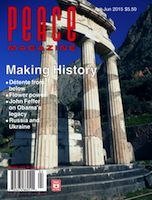
Peace Magazine Apr-Jun 2015, page 21. Some rights reserved.
Search for other articles by Rene Wadlow here
On 21 October 1967, the Pentagon in Washington, DC found itself besieged by 50,000 people protesting the military action in Vietnam. The US Department of Defense is located in the Pentagon, a largely windowless fortress closed to human sympathy. The events of that day are worked into Norman Mailer’s book, Armies of the Night, which won a Pulitzer Prize.
The year 1967 was the start of broader American opposition to the Vietnam War. In the earlier 1960s, the war was opposed mainly by people who were opposed to all wars, not specifically to that one. By 1967, television reporting had made the conflict a “living room war” and Americans were asking: “What are we doing there?” On April 15 a demonstration in Washington called “The Spring Mobilization,” was organized by the traditional peace and disarmament groups, including people who had participated in the nonviolent civil rights movement to end racial discrimination.
The Spring Mobilization brought together a coalition of anti-war groups, but it created no opposition to the war in Congress or on the President. To have an impact, something new was needed. New anti-war constituencies had to be drawn in and made visible.
In the early 1960s, there came to visibility, especially in California, youth called “hippies” from the slang term “hip” meaning being aware. Hip was in contrast to “the Beat Generation” of the 1950s, “beat” too much implying being beaten down. In fact, the two groups had much in common, and some people such as the poet Allen Ginsberg had an influence on both movements. Hippy music was by Bob Dylan and Leonard Cohen; its authors were Herman Hesse and Alan Watts on Taoism and Zen. Hippies focused on face-to-face, direct and open relationships, and opposed structured roles and bureaucratic authority. The dislike of formal authority kept them away from most peace-disarmament groups. However, by 1967, they could see that the Pentagon was a greater fortress of bureaucratic power and authority than the American Friends Service Committee, a leading group of the anti-Vietnam war movement.
Thus the Pentagon’s negative energies had to be exorcised. A call was circulated for a gathering to “cast mighty words of white light against the demon-controlled structure.” Hippies had a penchant for the occult, magic, and rituals from a mythic pagan past. There is also an older American tradition called “New Thought” that stresses the power of thought to influence events and to heal. Christian Science is probably its best known organization. While many of the New Thought individuals were middle class, their ideology created a sensitivity to visionary experience and the descent of divine fire. It emphasizes the immanence of the Spirit rather than a transcendent divinity. Their mysticism is neither escapist nor ascetic. Along with New Thought, many people became interested in meditation, sometimes drawn from Asian techniques, sometimes from Christianity.
On 21 October there came to Washington, in addition to peace activists who had joined the Spring Mobilization, a collection of what The East Village Other called “a contingent of witches, holy men, seers, prophets, mystics, saints, sorcerers, shamans, troubadours, minstrels and bards.” Their aim was to create a circle around the Pentagon and exorcise the negative, militaristic energies accumulated there. However, the Pentagon is outside the center of Washington, surrounded by parking lots. Most people working in the Pentagon must come by car. Army troops, heavily armed with rifles, and Pentagon marshals were able to stop the creation of a circle around the Pentagon, though they could not prevent groups from casting white light of healing energies.
Flowers, often worn in the hair, were a widely-used symbol of the Hippy movement. The 1955 “Sunflower Sutra” was one of the best known of the Ginsberg poems, and flowers were ever present in psychedelic paintings and posters. Flowers went with the “Make Love Not War” banner of the protesters—a way to undercut the crude he-manliness of American politics and war policy. It was a natural gesture to place a flower at the end of the Army rifles—a gesture of the soft against the hard, of life over death.
Thus the term “Flower Power” was born. The exorcism was not fully successful. The war in Vietnam went on until 1975, and the Pentagon presides today over more than 40 per cent of the world’s expenditure on arms. Nevertheless, the symbolic gesture has since inspired others. The flower given to the “forces of law and order” symbolically asserts that it is not the individual policeman or soldier who is being confronted but the “system” and its actions.
René Wadlow is president and a UN representative (Geneva) of the Association of World Citizens and editor of Transnational Perspectives.

Peace Magazine Apr-Jun 2015, page 21. Some rights reserved.
Search for other articles by Rene Wadlow here